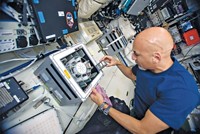Advertisement
Grab your lab coat. Let's get started
Welcome!
Welcome!
Create an account below to get 6 C&EN articles per month, receive newsletters and more - all free.
It seems this is your first time logging in online. Please enter the following information to continue.
As an ACS member you automatically get access to this site. All we need is few more details to create your reading experience.
Not you? Sign in with a different account.
Not you? Sign in with a different account.
ERROR 1
ERROR 1
ERROR 2
ERROR 2
ERROR 2
ERROR 2
ERROR 2
Password and Confirm password must match.
If you have an ACS member number, please enter it here so we can link this account to your membership. (optional)
ERROR 2
ACS values your privacy. By submitting your information, you are gaining access to C&EN and subscribing to our weekly newsletter. We use the information you provide to make your reading experience better, and we will never sell your data to third party members.
Water
How extreme bacteria squeeze water from a stone
Cyanobacteria survive in one of the harshest environments on Earth by mining water from the rocks they live on
by Katherine Bourzac
May 9, 2020
| A version of this story appeared in
Volume 98, Issue 18

Chile’s Atacama Desert is the driest place on Earth between the poles. Yet photosynthetic microbes called cyanobacteria somehow thrive on the region’s gypsum-rich rocks. Johns Hopkins University microbiologist Jocelyne DiRuggiero wanted to find out how it’s possible for a microbe to carry out photosynthesis in an environment where there is essentially no water available. So she collaborated with University of California, Irvine, materials scientist David Kisailus, who probed the biogeochemical relationship between microbe and rock using a battery of analytical tools usually reserved for studying nonliving materials. Using X-ray imaging, electron microscopy, and spectroscopy to examine Atacama rocks, Kisailus and DiRuggiero got a close look at what the bacteria are doing (Proc. Natl. Acad. Sci. USA 2020, DOI: 10.1073/pnas.2001613117). Gypsum is a crystalline material made up of calcium and sulfate ions layered with water molecules. Where the bacteria grow, there’s much more anhydrite, the water-free version of the mineral. Where there are no bacteria, gypsum remains. The researchers found that the cyanobacteria surround themselves with a film made of carboxylic acids, which seems to help them dissolve the rock in order to extract the water, leaving behind anhydrite. And they found that cyanobacteria prefer to live on the high-energy, rougher plane of the gypsum crystal, where their acids are more effective. Kisailus says he hopes to develop a cyanobacteria-inspired water-mining extraction technology for humans living in arid environments.





Join the conversation
Contact the reporter
Submit a Letter to the Editor for publication
Engage with us on Twitter